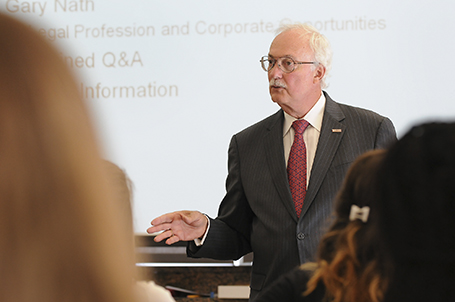Tuesday, Apr 8, 2014
Gary Nath's science education helped make him an expert in intellectual property law
by Adam Grybowski
Thousands of technologies have crossed the desk of Gary Nath '66 during his 21-year career as managing partner of Nath, Goldberg & Meyer. The firm, which specializes in intellectual property law, provides expertise on some of science’s most promising advances.
Before his career pivoted toward law, Nath had never even heard of one of the cornerstones of intellectual property, patents. “I didn’t understand what they were used for, why you would get them or who would get them,” he says.
However, Rider prepared Nath well for understanding the science behind patented technologies. Now the chair of the University’s Science Advisory Board, he studied chemistry and biology at Rider, harnessing his education to pursue a scientific career outside of the typical fields of research, academia and medicine.
After earning his degree, the Trenton native began doctoral studies in biochemistry at Temple University while teaching biology and chemistry at Trenton High School. Nath’s advanced science studies effectively ended when he began his patent career as an examiner in the U.S. Patent and Trademark Office. That turn came after visiting the research center of David Sarnoff, the president of RCA for much of the 20th century.
Located in West Windsor, the research center made its mark by innovating technology for consumer electronics and telecommunications. The facility incubated the work of a Nobel Prize winner, Herbert Kroemer, and the company pioneered technology that remains familiar today, such as color television, LEDs and liquid crystal displays.
Patents play an important role in protecting the competitive advantage of companies like RCA. After investing potentially ample amounts of time and large sums of money to create new products and technologies, companies patent them to create what is essentially a limited monopoly that they can exploit in the marketplace. “The only effective way to do that is to patent the product or technology," Nath says.
Meeting people who worked in RCA’s patent department altered Nath’s conception of what was possible with a science degree. After the visit, “I became conscious of the opportunity for scientists to be intimately involved with sciences through a different career path,” he says.
Nath took a job in the USPTO in 1969, when he also enrolled in law school at American College’s Washington College of Law. He went on to work as a patent attorney at FMC Corporation and then as general patent counsel for Warner-Lambert Company before founding the Nath Law Group in 1993. Working with clients all over the world, the firm is based in Alexandria, Va., in Old Town, the city’s historic center, and also has an office in the San Diego, Calif., area.
Nath, who lives in Maryland his wife, Judith, joined the University's Science Advisory Board in the early ’90s and now serves as its chair. His contributions to the Science Initiatives Fund helped the University renovate the Science and Technology Building, where, on the ground floor, a laboratory is named after him and Judith.
Most recently, he was a catalyst behind the science career bootcamp to help students find a focus for their career by exposing them to options outside of the lab. In addition to working with Dr. Laura Hyatt, associate dean of the College of Liberal Arts and Sciences, to create the weeklong event, he made several presentations during the bootcamp.
“All of us, no matter what our profession, have needed others to get where we are,” he says. “We all have to rely on the people who came before us. Rider has been extremely instrumental in enabling me to become who I am.”

